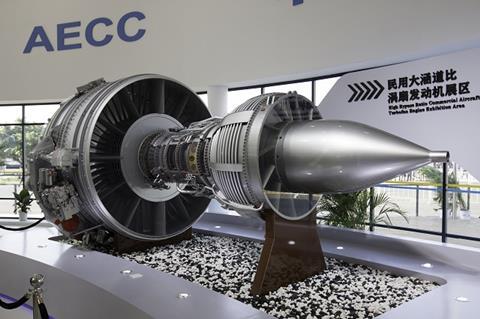China will double down on support for its domestic commercial aerospace industry in its development plans for the next five years, as part of efforts to wean off reliance on Western technology.
A Reuters report, citing officials speaking about the Chinese government’s five-year plan for 2021-2025, states that China will push forward development of the CJ-1000 turbofan, which was touted as a home-grown alternative to power Comac’s C919 narrowbody programme.

China is also looking to develop technology for a widebody powerplant.
At the sidelines of the fourth session of the 13th National People’s Congress, some of China’s aviation industry watchers have also urged the government to encourage the “preferential use” of home-grown aircraft programmes.
Tang Changhong, an academic from the Chinese Academy of Engineering who is also a senior engineer at Chinese airframer Avic, as well as Yang Yi, who is a representative from the National People’s Congress, submitted proposals calling for the promotion of indigenous aviation technologies.
The proposals call for “the formulation of … support policies” with the domestic regional market as the main support, “to encourage and guide airlines to give priority to the use and use of domestically-made regional aircraft”.
“[China] has long relied on imports for [commercial] aircraft, and the civil aviation market is controlled by foreign equipment and technology, which not only affects the safe and stable development of [China’s] civil aviation market, but also restricts the [formation] of a civil aviation [powerhouse],” the analysts argue.
While aircraft like the C919 and the ARJ21 regional aircraft are built in China, they rely heavily on Western technology, especially in the area of engines. The C919, for example, is powered by CFM Leap engines, while the ARJ21 has GE engines.
The analysts note that domestic regional aircraft, including the ARJ21, as well as Avic’s in-development MA700 turboprop, lack scale and fall short on reliability, when compared to their Western competitors.
To this end, they hope that the Chinese government will be able to encourage “large-scale” usage of the Chinese regional aircraft, through means such as increasing subsidies for carriers operating these aircraft, as well as reducing, or even exempting, tariffs on the aircraft.
Separately, Wu Ximing, who is the vice president at Avic-linked research unit Chinese Aeronautical Establishment, also called on the Chinese government to build up a “strategic” science and technology force in the aviation industry, to spur research and innovation in the sector.

The National People’s Congress sessions, where these announcements were made, are traditionally the most important event in the Chinese political calendar, as they set out the country’s wide-ranging agenda. This year’s session began on 5 March and spans seven days.
2021 will be a pivotal year for the commercial aerospace industry in China. Shanghai-based Comac has said it hopes to secure airworthiness certification for its C919 narrowbody programme by the end of the year.
It also comes amid looming trade tensions between China and the US — Comac, for instance, was added to a blacklist of “communist Chinese military companies”, by the Trump administration in its last days.
The move, which may or may not be overturned by the new Biden administration, seeks to ban future US investments into a list of Chinese companies alleged to have military links.
In late December, the US released its Military End-User list, which omitted Comac, but listed several Avic units that produce military aircraft, such as Chengdu Aircraft, Guizhou Aviation, Harbin General Aircraft, Shaanxi Aircraft Industry, Shenyang Aircraft Corporation, and Xian Aircraft Corporation, which produces the MA700 turboprop.


























